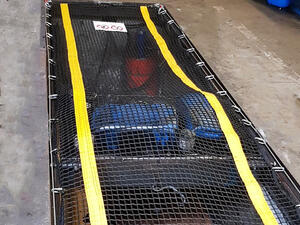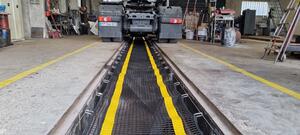How to secure your workshop or garage pit?

Measures to follow during design
The installation of a repair pit in a garage workshop must adhere to meticulous regulations to prevent all workplace accidents. Although there is no specific regulation for designing light vehicle maintenance pits, certain measures related to garage pit standards and regulations should be implemented. When designing the garage pit, it's important to follow certain measures:
- Provide access to the pit from both ends, with one of the exits designated as an emergency exit;
- Opt for pit alignment with the vehicle entry axis to avoid maneuvering inside the garage;
- Have a staircase designed according to current standards, with non-slip properties, coated with a non-combustible substance, and the same width as the pit;
- Mark a ground circulation plan to avoid interference risks between vehicles, mechanics, and customers;
- Incorporate a lifting system like an adjustable work platform to improve ergonomic working conditions;
- Install a system for oil or solvent drainage and recovery at the pit bottom;
- Anticipate a signaling system around the pit;
- Procure a suitable cover for the garage pit when not in use;
- Install adequate mobile and fixed lighting to prevent workplace accidents;
- Place a non-slip floor in the pit's bottom with a gradient of 1:120 to allow drainage of possible liquids or solvents;
- Opt for a light-colored paint for the pit's contour walls;
- Provide a ventilation system suitable for fire risk, incorporating polluted air extraction and fresh air intake;
- Include an alarm system to alert in case of ventilation problems or other issues;
- Consider a niche for the tools needed for vehicle maintenance or repair.
It is also essential to construct a pit with a depth between 1.40 meters and 1.60 meters. As for its length, it should allow the mechanic to exit from either side, even if the vehicle is positioned over the pit. It's also crucial to limit access to the maintenance pit for mechanics only, through a clearly identifiable barrier or demarcation system.
All of these measures should be considered when designing a maintenance pit in your garage. Proper training for mechanics using vehicle repair pits is also vital to avoid the still-too-common workplace accidents.
Preventing occupational hazards
There are numerous workplace accident risks in this line of work. Mechanics usually operate in hazardous conditions with high risks of falls, fires, or asphyxiation. Consequently, it's crucial to implement measures to prevent occupational hazards in a garage. In addition to measures during design and regular cleaning of the pit's bottom to prevent falls, mechanics should be informed about the risks and how to prevent or mitigate them. Workplace safety is paramount, making it essential to secure work within and around maintenance pits.
Fire and explosion hazards
To prevent fire and explosion risks, preventive measures are crucial. It's clear that using inflammable products at the pit's bottom and surroundings is prohibited. A mechanic also cannot perform engine oil drainage while simultaneously engaging in another risky task while in the maintenance pit. All tasks that might cause sparks are strictly forbidden in the pit. Tasks involving flames, such as welding, must be performed at least 3 meters away from the pit, even outside the demarcated area. If, for any reason, such tasks must be conducted on a vehicle positioned over the pit, additional safety and protection measures should be implemented by the mechanic. Smoking around the pit and even within the garage premises is also prohibited.
Falls
The risk of falls while working around and inside a workshop or garage pit is common. Hence, it's crucial to install protective equipment to prevent them. To prevent fall risks, it is recommended to:
- Install protective barriers around the pit. These barriers should be placed 1 meter away from the pit and have a minimum height of 0.7 meters. It's preferable to use protective barriers equipped with chains and posts anchored to the ground, along with a sign indicating that access is prohibited for non-personnel;
- Adhere to standards by placing a warning line 2 meters away from the pit's edge and marking the perimeter. This warning line could be a chain, a rigid strip, or a heavy-duty cable connecting removable posts;
- Cover the pit with a mesh cover when not in use. Consider using multiple mesh covers to facilitate handling by personnel. This cover must meet certain safety standards, including being at the same level as the ground to prevent tripping, being non-slip, and sufficiently robust to support heavy loads;
- Provide a sectioned guardrail around the pit perimeter;
- Purchase workshop or garage pit safety nets
In addition to all these measures, it's crucial and fundamental to train personnel in workstation safety and the proper use of personal protective equipment.
Other hazards
Risks of asphyxiation or intoxication from exhaust gases are also part of the occupational hazards in the mechanic profession. This is why ventilation system filters should be regularly inspected or replaced. There's also a risk of hearing impairment due to the noisy work environment. Some employees might suffer from tinnitus or other issues related to these sound or vibration nuisances.
